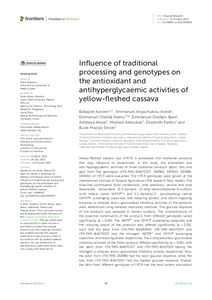| dc.contributor.author | Kareem, B. |
| dc.contributor.author | Irondi, E.A. |
| dc.contributor.author | Alamu, E.O. |
| dc.contributor.author | Ajani, E.O. |
| dc.contributor.author | Abass, A. |
| dc.contributor.author | Adesokan, M. |
| dc.contributor.author | Parkes, E. |
| dc.contributor.author | Maziya-Dixon, B. |
| dc.date.accessioned | 2022-10-27T15:19:19Z |
| dc.date.available | 2022-10-27T15:19:19Z |
| dc.date.issued | 2022 |
| dc.identifier.citation | Kareem, B., Irondi, E.A., Alamu, E.O., Ajani, E.O., Abass, A., Adesokan, M., ... & Maziya-Dixon, B. (2022). Influence of traditional processing and genotypes on the antioxidant and antihyperglycaemic activities of yellow-fleshed cassava. Frontiers in Nutrition, 9: 894843, 1-11. |
| dc.identifier.issn | 2296-861X |
| dc.identifier.uri | https://hdl.handle.net/20.500.12478/7915 |
| dc.description.abstract | Yellow-fleshed cassava root (YFCR) is processed into traditional products that may influence its bioactivities. In this study, the antioxidant and anti-hyperglycaemic activities of three traditional products (lafun, fufu and gari) from five genotypes (IITA-TMS-IBA070337, 182961, 182962, 182986, 183044) of YFCR were evaluated. The YFCR genotypes were grown at the International Institute of Tropical Agriculture (IITA) research field, Ibadan. The bioactive constituents (total carotenoids, total phenolics, tannins and total flavonoids), antioxidant [2,2-azinobis (3-ethyl-benzothiazoline-6-sulfonic acid) radical cation (ABTS•+) and 1,1-diphenyl-2- picrylhydrazyl radical (DPPH•) scavenging capacities, and reducing power], and starch-digesting enzymes (a-amylase and a-glucosidase) inhibitory activities of the products were determined using standard laboratory methods. The glucose response of the products was assessed in human subjects. The concentrations of the bioactive constituents of the products from different genotypes varied significantly (p < 0.05). The ABTS•+ and DPPH• scavenging capacities and the reducing power of the products also differed significantly (p < 0.05), such that the lafun from IITA-TMS-IBA182962, IITA-TMS-IBA070337 and IITA-TMS-IBA070337 had the strongest ABTS•+ and DPPH• scavenging capacities, and reducing power, respectively. The a-amylase and a-glucosidase inhibitory activities of the three products differed significantly (p < 0.05), with the lafun from IITA-TMS-IBA070337 and IITA-TMS-IBA07033 having the strongest a-amylase and a-glucosidase inhibitory activity, respectively. Also, the lafun from IITA-TMS-182986 had the least glucose response, while the fufu from IITA-TMS-IBA070337 had the highest glucose response. Overall, the lafun from different genotypes of YFCR had the most potent antioxidant and starch-digesting enzymes inhibitory activities and the least glucose responses. Hence, lafun may be a promising dietary intervention targeting oxidative stress, hyperglycaemia, and their resultant type 2 diabetes. |
| dc.description.sponsorship | CGIAR Research Program on Roots, Tubers and Bananas |
| dc.description.sponsorship | Bill & Melinda Gates Foundation |
| dc.format.extent | 1-11 |
| dc.language.iso | en |
| dc.subject | Antioxidants |
| dc.subject | Bioactive Food Components |
| dc.subject | Enzymes |
| dc.subject | Cassava |
| dc.subject | Processing |
| dc.subject | Varieties |
| dc.subject | Genotypes |
| dc.title | Influence of traditional processing and genotypes on the antioxidant and antihyperglycaemic activities of yellow-fleshed cassava |
| dc.type | Journal Article |
| cg.contributor.crp | Agriculture for Nutrition and Health |
| cg.contributor.crp | Maize |
| cg.contributor.crp | Roots, Tubers and Bananas |
| cg.contributor.affiliation | Kwara State University |
| cg.contributor.affiliation | International Institute of Tropical Agriculture |
| cg.coverage.region | Africa |
| cg.coverage.region | West Africa |
| cg.coverage.country | Nigeria |
| cg.coverage.hub | Southern Africa Hub |
| cg.coverage.hub | Eastern Africa Hub |
| cg.coverage.hub | Headquarters and Western Africa Hub |
| cg.researchtheme | Biotech and Plant Breeding |
| cg.researchtheme | Nutrition and Human Health |
| cg.researchtheme | Social Science and Agribusiness |
| cg.identifier.bibtexciteid | KAREEM:2022 |
| cg.isijournal | ISI Journal |
| cg.authorship.types | CGIAR and developing country institute |
| cg.iitasubject | Agronomy |
| cg.iitasubject | Cassava |
| cg.iitasubject | Food Security |
| cg.iitasubject | Food Systems |
| cg.iitasubject | Nutrition |
| cg.iitasubject | Plant Breeding |
| cg.iitasubject | Plant Production |
| cg.iitasubject | Value Chains |
| cg.journal | Frontiers in Nutrition |
| cg.notes | Open Access Journal; Published online: 14 Oct 2022 |
| cg.accessibilitystatus | Open Access |
| cg.reviewstatus | Peer Review |
| cg.usagerightslicense | Creative Commons Attribution 4.0 (CC BY 0.0) |
| cg.targetaudience | Scientists |
| cg.identifier.doi | https://dx.doi.org/10.3389/fnut.2022.894843 |
| cg.iitaauthor.identifier | Alamu Emmanuel Oladeji: 0000-0001-6263-1359 |
| cg.iitaauthor.identifier | Adebayo Abass: 0000-0003-1376-3608 |
| cg.iitaauthor.identifier | E J Parkes: 0000-0003-4063-1483 |
| cg.iitaauthor.identifier | Busie Maziya-Dixon: 0000-0003-2014-2201 |
| cg.futureupdate.required | No |
| cg.identifier.issue | 894843 |
| cg.identifier.volume | 9 |

